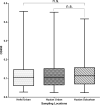High prevalence of Rickettsia spp. in ticks from wild hedgehogs rather than domestic bovine in Jiangsu province, Eastern China
- PMID: 35959365
- PMCID: PMC9360493
- DOI: 10.3389/fcimb.2022.954785
High prevalence of Rickettsia spp. in ticks from wild hedgehogs rather than domestic bovine in Jiangsu province, Eastern China
Abstract
Background: Spotted fever group Rickettsia (SFGR), containing various pathogenic Rickettsia spp., poses remarkable negative influences to public health by causing various severe or mild diseases. Information regarding prevalence of SFGR in ticks in Jiangsu province, Eastern China, is still limited and needs urgent investigations.
Methods: Hedgehog- and bovine-attached ticks were collected from Jiangsu province, Eastern China. DNA of individual ticks was extracted for nested polymerase chain reaction amplifications targeting gltA, 16S ribosomal RNA (rrs), ompA, ompB, and sca4 genes following with sequencing. SFGR-specific IgG antibodies in sera of local donators were evaluated using ELISA.
Results: Overall, 144 (83.2%) of the 173 ticks from hedgehogs and 2 (1.2%) of the 168 ticks from bovine were positive for one of the three identified Rickettsia spp., with significant difference between the two groups (P = 3.6e-52). Candidatus Rickettsia principis (9; 5.2%) and R. heilongjiangensis (135; 78.0%) were detected in Haemaphysalis flava rather than in H. longicornis ticks from hedgehogs. R. heilongjiangensis (1; 0.6%) and Candidatus R. jingxinensis (or Candidatus R. longicornii) (1; 0.6%) were identified in H. longicornis and Rhipicephalus microplus ticks from bovine, respectively. Phylogenetic analysis indicated Candidatus R. jingxinensis belonged to R. japonica subgroup, whereas Candidatus R. principis belonged to a novel subgroup. Higher serological prevalence of spotted fever and SFGR-specific IgG antibody level in humans were observed around the investigated area than in urban areas, without significant difference.
Conclusion: Candidatus R. principis and Candidatus R. jingxinensis were identified in Jiangsu province, Eastern China, and fully genetically characterized for the first time. The higher prevalence of SFGR in hedgehog-attached ticks as well as the higher SFGR-specific IgG antibody level and seropositive rate in humans around the investigated area suggested that more attention should be paid to SFGR. This pathogen is usually transmitted or harbored by wild animals and ticks. This study provides important epidemiological data for both physicians and public health officers in developing early prevention and control strategies against potential Rickettsia infections and in the preparation of suitable testing and treatment needs for rickettsiosis in the endemic areas.
Keywords: Candidatus Rickettsia jingxinensis; Candidatus Rickettsia principis; Rickettsia heilongjiangensis; hedgehog; spotted fever group Rickettsia; tick.
Copyright © 2022 Qi, Ai, Jiao, Wang, Wu, Wang, Zhang, Qin, Hu, Lv, Lu, Zhu, Mao, Qi, Li and Tan.
Conflict of interest statement
The authors declare that the research was conducted in the absence of any commercial or financial relationships that could be construed as a potential conflict of interest.
Figures




Similar articles
-
Molecular detection of spotted fever group rickettsiae in hedgehogs (Erinaceus amurensis) and hedgehog-attached ticks in Xuyi County, Southeast China.Exp Appl Acarol. 2022 Sep;88(1):97-111. doi: 10.1007/s10493-022-00721-y. Epub 2022 Sep 12. Exp Appl Acarol. 2022. PMID: 36097185 Free PMC article.
-
The first direct detection of spotted fever group Rickettsia spp. diversity in ticks from Ningxia, northwestern China.PLoS Negl Trop Dis. 2025 Jan 2;19(1):e0012729. doi: 10.1371/journal.pntd.0012729. eCollection 2025 Jan. PLoS Negl Trop Dis. 2025. PMID: 39746018 Free PMC article.
-
[Investigation and research on ticks carrying spotted fever group rickettsia in the border area of Tumen River Basin].Zhonghua Yu Fang Yi Xue Za Zhi. 2019 Nov 6;53(11):1130-1135. doi: 10.3760/cma.j.issn.0253-9624.2019.11.011. Zhonghua Yu Fang Yi Xue Za Zhi. 2019. PMID: 31683400 Chinese.
-
A systematic review and meta-analysis of the prevalence of tick-borne SFGR in China from 2000 to 2022.PLoS Negl Trop Dis. 2024 Oct 9;18(10):e0012550. doi: 10.1371/journal.pntd.0012550. eCollection 2024 Oct. PLoS Negl Trop Dis. 2024. PMID: 39383137 Free PMC article.
-
Mapping the global distribution of spotted fever group rickettsiae: a systematic review with modelling analysis.Lancet Digit Health. 2023 Jan;5(1):e5-e15. doi: 10.1016/S2589-7500(22)00212-6. Epub 2022 Nov 21. Lancet Digit Health. 2023. PMID: 36424337 Free PMC article.
Cited by
-
Identification of Bacterial Communities and Tick-Borne Pathogens in Haemaphysalis spp. Collected from Shanghai, China.Trop Med Infect Dis. 2022 Dec 1;7(12):413. doi: 10.3390/tropicalmed7120413. Trop Med Infect Dis. 2022. PMID: 36548668 Free PMC article.
-
Molecular Identification of Spotted Fever Group Rickettsiae in Ticks in the Republic of Korea.Pathogens. 2024 Jul 10;13(7):575. doi: 10.3390/pathogens13070575. Pathogens. 2024. PMID: 39057802 Free PMC article.
-
Complete genome sequencing and comparative genomic analyses of a new spotted-fever Rickettsia heilongjiangensis strain B8.Emerg Microbes Infect. 2023 Dec;12(1):2153085. doi: 10.1080/22221751.2022.2153085. Emerg Microbes Infect. 2023. PMID: 36440590 Free PMC article.
-
Diversity of Rickettsiales bacteria in five species of ticks collected from Jinzhai County, Anhui Province, China in 2021-2022.Front Microbiol. 2023 Apr 28;14:1141217. doi: 10.3389/fmicb.2023.1141217. eCollection 2023. Front Microbiol. 2023. PMID: 37187539 Free PMC article.
-
Whole genome sequence and comparative genomic analysis of novel Rickettsia koreansis strain CNH17-7 isolated from human.Eur J Clin Microbiol Infect Dis. 2024 Oct;43(10):1909-1918. doi: 10.1007/s10096-024-04876-x. Epub 2024 Jul 20. Eur J Clin Microbiol Infect Dis. 2024. PMID: 39031268
References
-
- Chahan B., Jian Z., Jilintai, Miyahara K., Tanabe S., Xuan X., et al. . (2007). Detection of DNA closely related to 'Candidatus rickettsia principis' in haemaphysalis danieli recovered from cattle in xinjiang uygur autonomous region area, China. Vet. Parasitol. 144, 184–187. doi: 10.1016/j.vetpar.2006.09.019 - DOI - PubMed
Publication types
MeSH terms
Substances
LinkOut - more resources
Full Text Sources
Miscellaneous

